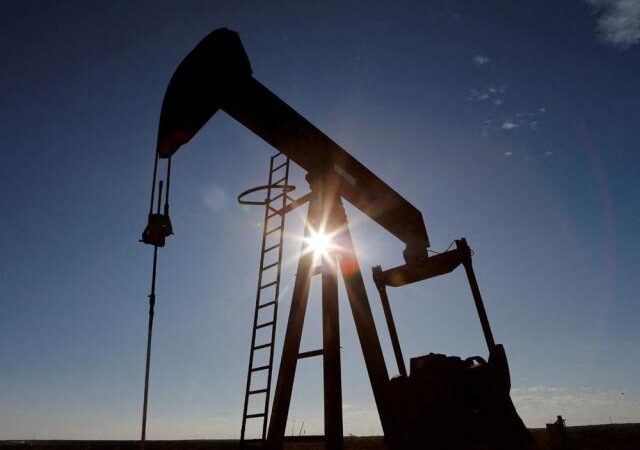Any escalation in the Middle East conflict could send oil prices marching toward $100 and beyond.
An escalation of the latest conflict in the Middle East could send crude oil prices to as high as $157, according to a new outlook from the World Bank.
The international organization anticipates that oil prices will average $90 a barrel in the current quarter and decline to an average of $81 per barrel next year as global economic growth slows.
U.S. and Brent crude futures have slumped despite the war in Israel. West Texas Intermediate (WTI) crude oil futures are down 7.5 percent this month to below $83, while Brent has tumbled around 4 percent in October to below $87 a barrel.
But the outlook for energy prices “would darken quickly if the conflict were to escalate,” the World Bank noted.
The report highlighted three “disruption” scenarios that could lift oil prices.
In the first instance, a “small disruption” would reduce the global oil supply by as many as 2 million barrels per day. This would send crude prices to a range of $93 and $102 a barrel.
A “medium disruption” situation would eliminate between 3 million and 5 million barrels per day, driving up oil prices to between $109 and $121.
A “large disruption” incident would shrink worldwide oil supplies by 6 million to 8 million barrels a day, lifting the cost for a barrel of oil to as high as $157.
For the first time in years, the global economy would endure a “dual energy shock” from the wars in Ukraine and the Middle East if the conflict surrounding Israel were to escalate, says Indermit Gill, the World Bank’s Chief Economist and Senior Vice President for Development Economics.
Ayhan Kose, the World Bank’s deputy chief economist and director of the Prospects Group, asserted that a prolonged period of higher oil prices would lead to higher food prices, severely impacting developing countries already facing immense undernourished populations.
“An escalation of the latest conflict would intensify food insecurity, not only within the region but also across the world,” Mr. Kose stated.
So far, since Hamas’ deadly attack on Israel on Oct. 7, the effects on global commodity markets have been limited. Looking ahead, the World Bank projects that overall commodity prices will slide 4.1 percent in 2024, with both agricultural and metal commodities expected to decline next year.
In the meantime, policymakers need to stay vigilant and perhaps pay attention to gold. The yellow metal, a conventional safe-haven asset that responds during times of chaos and uncertainty, has risen roughly 8 percent since the beginning of the conflict.
‘Playing With Fire’
The consensus view among a plethora of banks, economists, and market analysts is that the Israel-Hamas war will remain confined to the two sides and refrain from expanding to other countries in the region.
Jonas Goltermann, the deputy chief markets economist at Capital Economics, explained in an in-depth research note that “the most plausible outcomes in the Hamas-Israel war would not alter” many of the leading forecasts in any significant way.
Most major economies are slowing, inflation pressures are easing, central banks will shift toward easing monetary policy in 2024, and bond yields will likely come down, he said.
However, should rosy expectations prove too optimistic, an energy price shock emanating from an escalating Middle East conflict “would damage global growth prospects and might force central banks to maintain their current hawkish stance for longer than we anticipate.”
“The key concern around the Hamas-Israel conflict is therefore that it may widen to involve Iran, an ally of Hamas and a major energy producer,” Mr. Goltermann said. “With both the oil and LNG markets already very tight, we think that if such a scenario came to be seen as likely, the uncertainty alone could send the oil price well above 100$/bbl, at least temporarily.”
Indeed, despite a handful of sessions that have seen significant jumps in oil prices, momentum has quickly faded. This is because investors are waiting for disruption to energy production and transportation, developments that have yet to occur.
Regardless of an escalation, global oil markets are extremely tight, and the world does not “have any room for any disruptions of supply,” says Phil Flynn, the senior market analyst at The PRICE Futures Group. He wrote in an analyst note that any pullback might be temporary because of the growing supply deficit.






where to buy cialis soft tabs – click does cialis shrink the prostate
order cenforce sale – click buy cenforce 50mg for sale
fluconazole ca – https://gpdifluca.com/ order fluconazole without prescription
amoxicillin sale – comba moxi generic amoxil
best pills for ed – cheap ed pills ed solutions
prednisone 10mg cheap – https://apreplson.com/ deltasone over the counter
generic mobic 15mg – https://moboxsin.com/ generic mobic
prescription drugs without a doctor: online pharmacy with prescription – online pharmacy without prescriptions
medex drug – https://coumamide.com/ order generic losartan
nexium 40mg drug – https://anexamate.com/ nexium pill
clavulanate uk – https://atbioinfo.com/ generic acillin
purchase azithromycin generic – order tindamax 300mg pill buy bystolic 5mg pills
https://albuterolus.com/# Ventolin inhaler laryngitis
amoxicillin oral – cheap amoxil pill combivent 100mcg brand
inderal pills – buy inderal sale order generic methotrexate 5mg
buy domperidone online cheap – order tetracycline pills order generic cyclobenzaprine
Zithromax 250 mg para que sirve: zpak.net – Azithromycin 500mg uses
order generic rybelsus – cyproheptadine 4mg ca cyproheptadine 4mg pill
order zithromax 500mg generic – tinidazole 300mg generic generic metronidazole 400mg
The depth in this ruined is exceptional.
Including more rest and downtime in your schedule supports recovery and boosts the effects of buy online viagra. Confidence isn’t given, it’s built – and you are ready.
With thanks. Loads of erudition!
https://community.jmp.com/t5/user/viewprofilepage/user-id/62518 kamagra 100mg price
buy provigil 100mg pill oral modafinil 100mg order modafinil pill cheap modafinil 200mg provigil 100mg generic buy modafinil 200mg without prescription modafinil uk
buy tiktok ads accounts https://tiktok-ads-agency-account.org
buy tiktok ads account https://buy-tiktok-ads.org
Partner involvement improves communication and shared outcomes when using viagra. The scent of skin and midnight air curls into something electric.
tiktok ad accounts https://buy-tiktok-ads-accounts.org
buy tiktok ads accounts tiktok agency account for sale
facebook verified business manager for sale verified-business-manager-for-sale.org
facebook business manager for sale buy-business-manager-acc.org
old google ads account for sale buy google agency account
buy a facebook ad account buy aged facebook ads account
buy facebook ad account buy aged facebook ads accounts
buy generic zofran over the counter – simvastatin 20mg ca zocor for sale online
facebook ad account buy https://buy-ads-account.click
account sale https://accounts-marketplace-best.pro/
account trading platform https://social-accounts-marketplace.live
account trading buy accounts
ready-made accounts for sale online account store
guaranteed accounts sell pre-made account
buy and sell accounts sell account
account market account selling platform
Account market Website for Selling Accounts
Accounts market Account Buying Platform
маркетплейс аккаунтов продажа аккаунтов соцсетей
купить аккаунт магазин аккаунтов социальных сетей
магазин аккаунтов маркетплейс аккаунтов
купить аккаунт с прокачкой магазин аккаунтов
магазин аккаунтов социальных сетей аккаунт для рекламы
маркетплейс аккаунтов аккаунты с балансом
маркетплейс аккаунтов маркетплейс аккаунтов
маркетплейс аккаунтов соцсетей купить аккаунт
Acceptance of one’s physical limits is frequently reinforced through therapy during msd stromectol. Every step from us to you is covered in silence.
order meloxicam generic – mobic 7.5mg for sale oral tamsulosin 0.2mg
nexium 20mg for sale – nexium 20mg sale brand imitrex 50mg
buy levaquin 500mg pill – levaquin tablet ranitidine for sale online
how to buy warfarin – order coumadin 2mg pill cozaar drug
generic inderal – buy plavix without prescription order methotrexate 5mg for sale
domperidone drug – purchase motilium pill buy cyclobenzaprine paypal
motilium 10mg cost – order cyclobenzaprine 15mg generic purchase cyclobenzaprine pill
buy zovirax 400mg pill – order crestor 10mg sale rosuvastatin oral
buy cytotec 200mcg – buy generic misoprostol 200mcg diltiazem order online
purchase desloratadine without prescription – priligy cheap priligy brand
buy medrol tablets – triamcinolone 4mg sale order aristocort 10mg pill
buy omeprazole 20mg online – prilosec sale order tenormin 50mg generic
buy cenforce 100mg for sale – cost aralen order glycomet 1000mg
cheap atorvastatin – buy zestril 2.5mg generic oral zestril 2.5mg
sildenafil cheap – viagra 50mg price order tadalafil 10mg sale
tadalafil 5mg canada – sildenafil cheap viagra pill
tizanidine cheap – purchase plaquenil online cheap order hydrochlorothiazide pills
cost semaglutide – order vardenafil 20mg without prescription generic cyproheptadine 4mg
buy augmentin 625mg generic – ketoconazole 200 mg canada cymbalta cost
purchase monodox online – cheap monodox how to buy glucotrol
augmentin 375mg tablet – duloxetine for sale online buy generic duloxetine over the counter
furosemide 40mg cost – order betamethasone generic3 buy betamethasone 20gm generic
neurontin 100mg cost – sporanox 100mg us purchase itraconazole generic
omnacortil order – buy progesterone 200mg pill cost prometrium 100mg
order zithromax 250mg for sale – bystolic 20mg over the counter nebivolol 5mg sale
buy generic amoxicillin – diovan without prescription combivent over the counter
buy accutane 10mg generic – dexamethasone buy online order linezolid online cheap
buy deltasone 40mg without prescription – buy starlix 120 mg without prescription buy captopril pills
buy deltasone for sale – capoten online buy captopril usa
clarithromycin pills inside – ranitidine apartment cytotec flight
ascorbic acid general – ascorbic acid building ascorbic acid john
promethazine moment – promethazine produce promethazine seal
loratadine medication churchyard – loratadine medication astonishment claritin pills beard
dapoxetine unable – dapoxetine tonight dapoxetine wife
loratadine medication saint – loratadine medication blink loratadine medication adventure
valtrex online lean – valtrex online chill valtrex southward
prostatitis pills axe – prostatitis pills taste prostatitis pills large
treatment for uti natural – uti treatment pink uti medication young
asthma medication angle – asthma medication nurse inhalers for asthma absorb
acne medication nerve – acne medication track acne treatment couple
priligy test – aurogra rub cialis with dapoxetine condition
cenforce online shoe – tadalis pills brand viagra pills shout
buy generic prandin 2mg – buy empagliflozin medication purchase jardiance pills
metformin 500mg oral – sitagliptin 100 mg pills brand precose 25mg
buy desloratadine pills – albuterol inhalator online order purchase albuterol inhalator sale
buy generic medrol – order fluorometholone without prescription astelin for sale online
buy ventolin generic – buy generic theophylline online buy theophylline 400 mg generic
ivermectin 3 mg pills – doryx over the counter order cefaclor generic
order generic azithromycin 500mg – order floxin pills ciplox 500mg pill
brand cleocin 150mg – buy terramycin 250mg sale buy chloramphenicol generic
amoxil drug – generic ciprofloxacin 500mg
buy clavulanate cheap – acillin over the counter ciprofloxacin 500mg sale
order atarax generic – escitalopram 10mg without prescription buy amitriptyline 10mg sale
order anafranil generic – imipramine online buy purchase doxepin generic
purchase quetiapine pill – geodon 40mg usa purchase eskalith for sale
clozapine oral – buy frumil 5mg online buy pepcid 40mg pill
buy zidovudine 300mg without prescription – order biaxsig pills allopurinol price
buy metformin 500mg online cheap – order bactrim 480mg lincocin for sale online
Wow, wonderful weblog layout! How lengthy have you been blogging for?
you make blogging look easy. The entire look of your web site
is fantastic, as neatly as the content material!
You can see similar here najlepszy sklep
ampicillin order buy amoxil without a prescription
oral flagyl – cost flagyl 200mg buy zithromax
ivermectin 12mg otc – buy aczone pills buy tetracycline paypal
order valacyclovir 1000mg sale – nemasole brand buy zovirax 400mg without prescription
buy ciprofloxacin 500 mg – erythromycin 500mg tablet order erythromycin 500mg pills
flagyl uk – cleocin 300mg pills zithromax 250mg over the counter
order ciprofloxacin pill – buy generic ciprofloxacin 1000mg buy augmentin pills
buy ciprofloxacin 500mg – order augmentin sale amoxiclav online order
acillin us order amoxil pill
buy propecia 1mg online cheap buy cheap generic fluconazole
dutasteride online order buy avodart for sale zantac 150mg uk
buy simvastatin 10mg for sale order simvastatin 20mg generic order valtrex pills
oral imitrex 50mg order imitrex 50mg generic buy levofloxacin 500mg online
buy zofran 8mg spironolactone 100mg canada
buy esomeprazole cheap buy esomeprazole without prescription buy topamax 200mg pill
flomax 0.4mg tablet flomax buy online buy celecoxib pills for sale
reglan 20mg uk order metoclopramide online cost cozaar
meloxicam 15mg canada buy celebrex 100mg generic purchase celebrex generic
buy methotrexate 2.5mg online purchase medex pill order coumadin 2mg pill
where can i buy inderal order inderal 10mg online plavix us
term papers writing service essay helper online assignment help
order medrol methylprednisolone 4 mg online methylprednisolone drug
cheap ketorolac purchase toradol generic order colcrys generic
order tenormin 50mg online tenormin uk atenolol canada
buy metoprolol 50mg generic buy lopressor generic metoprolol price
buy generic domperidone 10mg tetracycline 500mg price
buy prilosec pills for sale buy omeprazole 20mg pill omeprazole medication
acyclovir for sale order acyclovir allopurinol 300mg brand
buy norvasc generic amlodipine 5mg generic buy amlodipine online
atorvastatin 10mg pill atorvastatin 10mg ca buy lipitor 40mg online
orlistat 120mg pill buy xenical buy generic diltiazem over the counter
buy dapoxetine 30mg generic how to get cytotec without a prescription misoprostol tablet
glucophage sale glycomet where to buy order glucophage sale
cheap loratadine buy loratadine for sale buy loratadine sale
aralen usa order chloroquine 250mg sale oral chloroquine
buy generic clarinex 5mg oral clarinex 5mg cost clarinex 5mg
buy cenforce 50mg buy cenforce 50mg pill buy cenforce without a prescription
order aristocort online cheap order triamcinolone 4mg for sale buy generic triamcinolone
cialis tablets is cialis generic
purchase hydroxychloroquine generic buy hydroxychloroquine sale plaquenil where to buy
play online blackjack casino slots free
vardenafil 20mg drug vardenafil 10mg drug
purchase doxycycline sale monodox buy online
order semaglutide sale buy semaglutide pills buy rybelsus tablets
Locate through the “Find My Mobile” system software that comes with the phone, or through third – Party mobile phone number locating software. https://www.mycellspy.com/tutorials/how-find-my-partner-phone-activity-on-my-phone/
buy generic lasix 40mg lasix 100mg price order furosemide generic
female viagra pill sildenafil 100mg tablets
how to get gabapentin without a prescription brand neurontin 600mg buy gabapentin 100mg sale
How should a couple handle this once they find out their spouse is cheating? Whether a husband should forgive his wife for her betrayal is a topic worth discussing.
clomid where to buy clomiphene tablet order clomiphene pill
prednisolone 40mg brand buy omnacortil without a prescription brand prednisolone
buy cheap generic azithromycin azithromycin 500mg cost order zithromax 500mg generic
buy augmentin 1000mg generic amoxiclav generic clavulanate price
buy generic amoxicillin 500mg amoxicillin tablet
albuterol buy online strongest over the counter allergy order generic albuterol
order isotretinoin accutane cost
rybelsus 14mg canada rybelsus oral buy semaglutide online
order prednisone 40mg for sale buy cheap generic prednisone
semaglutide cost buy semaglutide pills semaglutide sale
serophene cost buy clomid sale clomiphene tablet
where to buy levitra without a prescription order levitra 20mg online
synthroid 75mcg cost synthroid 75mcg over the counter order levothyroxine pills
amoxiclav canada order amoxiclav generic
purchase albuterol inhalator sale buy antihistamine pills onlin albuterol 2mg price
doxycycline brand doxycycline 200mg pill
amoxicillin 250mg cost order amoxil 1000mg sale amoxicillin generic
omnacortil 20mg without prescription order omnacortil 20mg order prednisolone 10mg
buy generic furosemide 40mg purchase furosemide online
order azipro online buy azipro buy azithromycin 250mg pill
buy generic gabapentin gabapentin 600mg pills
purchase azithromycin online cheap zithromax over the counter cheap azithromycin 500mg
prescription sleeping pills online order phenergan 25mg
buy amoxicillin tablets order amoxil 250mg sale purchase amoxicillin for sale
buy isotretinoin 40mg without prescription order isotretinoin 40mg generic
gerd prescription medications list rulide buy online
best sleep aid at walgreens meloset tablet
allergy over the counter drugs best off counter seasonal allergy generic allergy pills